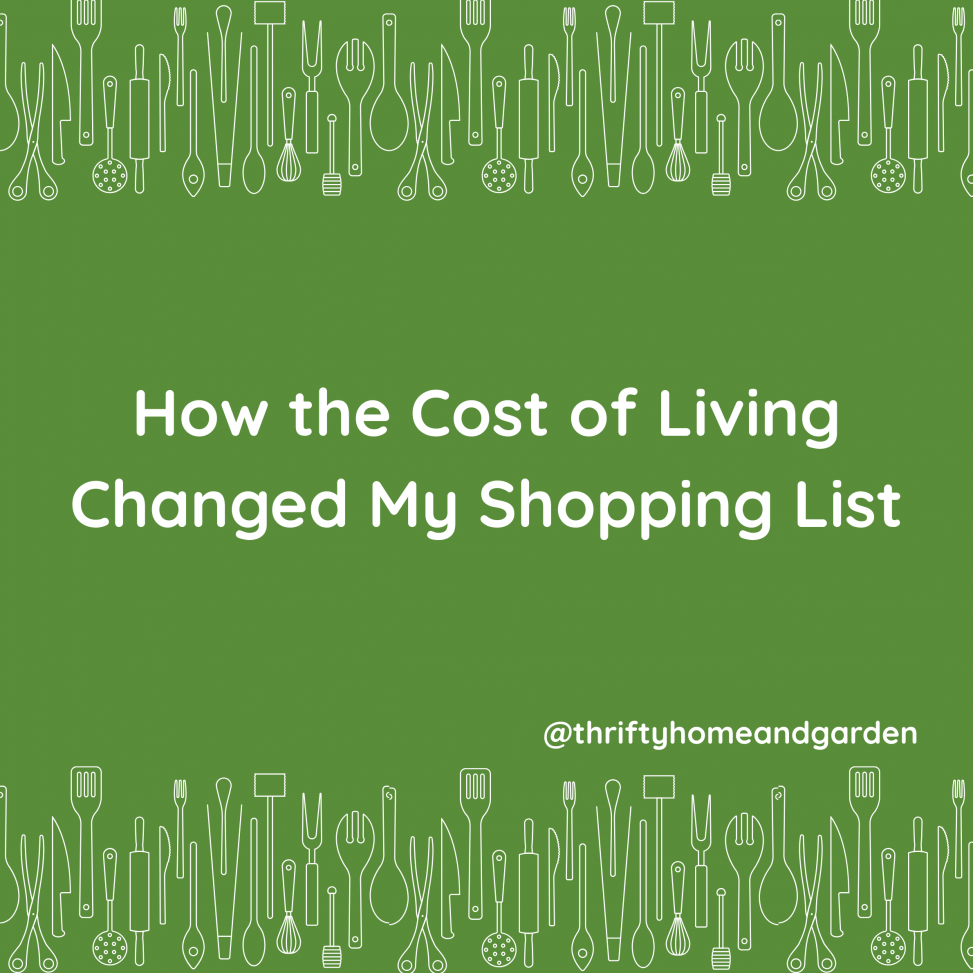When the Money Saving Expert, Martin Lewis, recently posed a question on Twitter, it struck a chord with his followers, myself included. He asked, “What things will you NEVER pay full price for? When is the sticker price always too much so you need to get it for less?” The overwhelming response confirmed a widespread shift in consumer habits, a collective tightening of belts in response to the relentless rise in the cost of living.
This simple question prompted a deeper reflection on my own household’s budget. Our shopping list today bears little resemblance to the one from just a few years ago. This transformation has been driven primarily by financial necessity, but it has also been shaped by a stubborn refusal to pay inflated prices for everyday goods. The economic climate has forced a radical rethink of what constitutes an “essential” item. In this process, we’ve not only discovered ways to save money but have also stumbled upon a healthier, more resourceful way of living. It’s a journey of adaptation, revealing how financial constraints can unexpectedly lead to positive changes in our kitchens and our well-being.
The Great Unsubscribe: Items Dropped from Our List
There are certain items that once held a permanent, unquestioned spot on our weekly shopping list. Their absence now would have been inconceivable just a short while ago, yet today, our fridge and pantry look starkly different. The decision to cut back wasn’t just about swapping for cheaper alternatives; in some cases, it meant forgoing items entirely.
Butter and Milk: The Fallen Staples
Perhaps the most dramatic change has been our consumption of butter and milk. These were once the bedrock of our daily diet—milk splashed generously over cereal and stirred into countless cups of tea and coffee, and butter slathered on toast or used as a rich base for cooking. Now, they are treated as luxuries rather than staples. We no longer buy them for everyday use. Instead of butter, we’ve turned to homemade alternatives like hummus or mayonnaise to add moisture and flavour to sandwiches. This simple switch has not only cut costs but has also introduced new tastes and textures to our meals.
Tea and coffee are now taken black. Initially, this felt like a significant sacrifice, a daily reminder of our financial constraints. However, we’ve discovered an unexpected benefit: we feel better for it. Without the dairy, the true, unadulterated flavours of the coffee beans and tea leaves shine through. This small adjustment has evolved from a cost-saving measure into a genuine preference.
Gravy Granules and Stuffing Mixes: The Convenience Cull
Another category to face the chop was pre-packaged convenience foods. Gravy granules and stuffing mixes like Paxo were once our go-to solutions for a Sunday roast, prized for their speed and simplicity. Now, they are relics of a bygone era of spending. The high prices for what are essentially flavoured powders became impossible to justify.
Instead, we’ve rediscovered the art of making gravy from scratch. By using the natural juices from a roast, combined with a little flour and stock, we can create a gravy with a depth of flavour that no granule can replicate. It has been a learning curve, and I’ve become quite resourceful, sometimes throwing in a splash of Worcestershire Sauce, a spoonful of Marmite, or even the vegetable water to get the colour and consistency just right. It takes more effort, but the result is infinitely more satisfying and virtually free.
Similarly, stuffing is now made from scratch. I found a wonderful recipe on Jack Monroe’s website that ingeniously uses vegetable peelings and breadcrumbs. This method not only eliminates the need to buy a pre-made mix but also reduces food waste. The questionable ingredients list of dried granules has been replaced by a wholesome, homemade stuffing that tastes far superior and aligns with our goal of living more sustainably.
The Own-Brand Revolution
For years, I was a loyalist to certain brands. The idea of swapping Heinz Tomato Ketchup or Heinz Baked Beans for a supermarket’s own-brand equivalent was almost unthinkable. I was convinced that the taste and quality could never compare. The cost of living crisis, however, has a way of challenging even the most deeply ingrained brand allegiances.
Driven by the need to slash our grocery bill, we decided to experiment. We started small, swapping tinned tomatoes and pulses, where the difference seemed negligible. Emboldened by our success, we moved on to the titans of our pantry: the ketchup and baked beans. I braced myself for disappointment, but it never came. To our surprise, the own-brand versions were not just acceptable; they were genuinely good.
I recently read a fascinating insight that it takes about ten exposures to a new taste for it to become the norm. Our experience has proven this to be true. Our taste buds have adapted, and what once seemed like a downgrade now feels perfectly normal. Our bank account has certainly appreciated the switch, with savings of up to 50% on some items. This journey has taught me that brand loyalty often has more to do with habit and marketing than with any tangible difference in quality.
Shrinkflation: The Supermarket Sleight of Hand
As consumers become more price-savvy, manufacturers and retailers have become more cunning in their tactics. One of the most insidious trends to emerge is “shrinkflation”—the practice of reducing the size or quantity of a product while keeping the price the same, or even increasing it slightly. It’s a subtle form of price hike, designed to go unnoticed by the casual shopper.
Butter is a classic example. The standard 250g block, a familiar sight in dairy aisles for decades, is increasingly being replaced by 200g versions. At a glance, the packaging looks identical, and the price might seem competitive. Only a careful check of the weight reveals that you are getting 20% less for your money. Toothpaste is another culprit. The typical 100ml tube is often shrunk down to 75ml, a detail easily missed when you’re in a hurry.
Navigating the supermarket now requires a new level of vigilance. It’s no longer enough to compare headline prices; you must become an expert in checking weights, volumes, and price-per-unit information. This constant state of alert can be exhausting, but it’s essential to ensure you’re getting genuine value. It feels like a cat-and-mouse game, where shoppers must constantly be on guard against the sneaky tactics employed to part them from their hard-earned money.
Back to Basics: The Revival of Home Cooking
The most profound and positive change to come out of this period of financial pressure has been our return to fundamental cooking skills. By cutting out convenience foods and expensive ingredients, we’ve been forced to become more creative and resourceful in the kitchen. This has not only saved us a significant amount of money but has also made our diet healthier and more varied.
We plan our meals meticulously, basing them on seasonal produce and special offers. We’ve learned to cook from scratch, turning basic, inexpensive ingredients like lentils, beans and root vegetables into hearty and flavourful dishes. We bake our own bread, make our own sauces, and preserve gluts of seasonal fruit and vegetables.
This shift has reconnected us with our food in a way that convenience culture had severed. We understand where our food comes from, and we appreciate the effort that goes into preparing it. There is a deep sense of satisfaction in sitting down to a meal that has been created from simple, wholesome ingredients, using skills that have been passed down through generations. It has transformed cooking from a daily chore into a creative and rewarding activity. We are eating better, spending less and wasting nothing—a powerful trifecta in these challenging economic times.
Charting a New Course
The journey forced upon us by the cost of living crisis has been one of unexpected discovery. What began as a series of painful sacrifices has evolved into a more mindful, sustainable, and ultimately more fulfilling way of life. We have shed the shackles of brand loyalty, become wary of marketing tricks, and rediscovered the joy and value of home cooking. Our shopping list may be shorter and simpler, but our lives feel richer for it.
This experience has armed us with a new perspective on consumption. It has taught us that true value lies not in a brand name or fancy packaging, but in quality, resourcefulness, and the satisfaction of providing for ourselves. As we continue to navigate these tough economic times, the lessons learned in our kitchen will serve as our guide, reminding us that with a little creativity and a willingness to adapt, it is possible to not just survive, but to thrive.
Further Reading: Winter Comfort Food – Casseroles and Stews, English Pudding Season, The Olio App – Reduce Food Waste, How to Shop Ethically, From Garden to Oven: Autumn Vegetable Bakes for the Family, Warming Autumn Soups to Soothe the Soul






